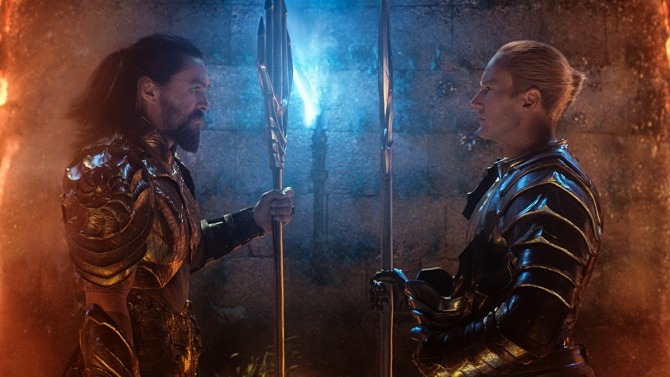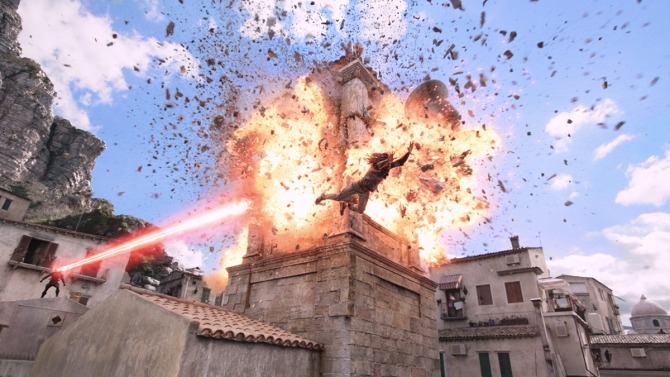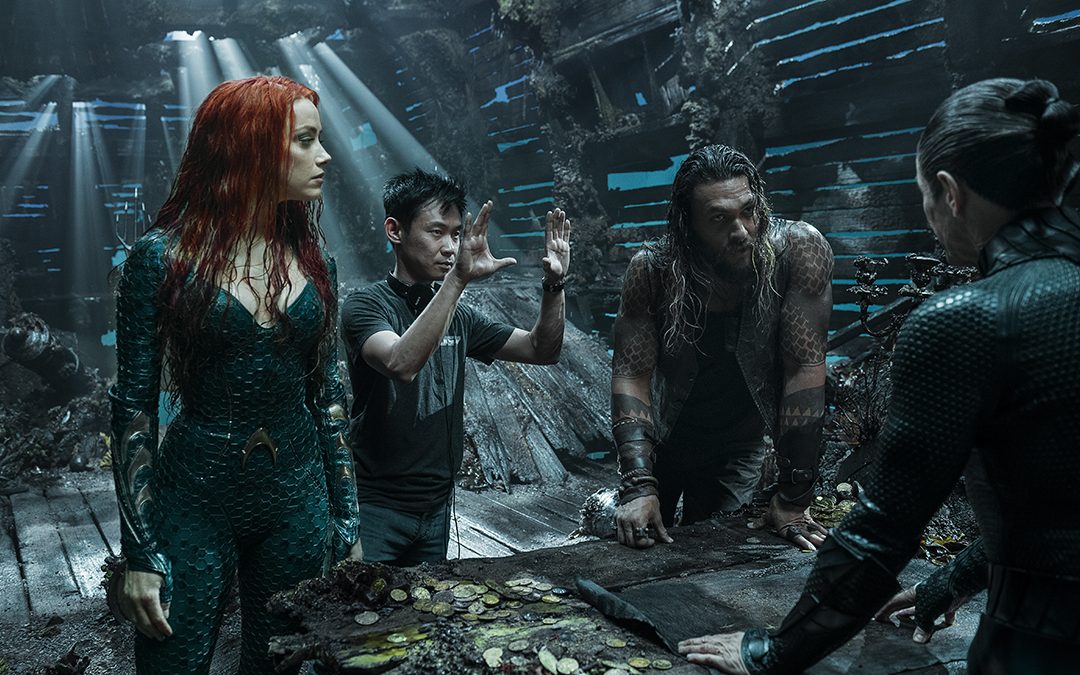James Wan is excited – and tired. Not that you’d know it. It’s the morning after the London premiere of the director’s latest, Aquaman – the first solo big-screen adventure for DC’s underwater superhero – and he’s on commendably enthusiastic form.
“It’s been pretty full on,” Wan deadpans with a hearty laugh as he greets Den of Geek. If there’s any pressure on the director to deliver a hit on behalf of DC’s Extended Universe, he’s certainly not showing it.
Taking on a huge comic-book blockbuster is no mean feat. But after making a name for himself with a number of ridiculously successful, genre-embracing horror breakouts (Saw, Insidious, The Conjuring) and showing he could direct action on a much larger scale with Fast & Furious 7 (the franchise’s highest-grossing entry), Wan proved himself capable of the job.
So, why this huge comic-book blockbuster, then? “Definitely the fact that Aquaman hasn’t really been done before was a big part of it,” he says. “I feel like there’s so many superhero characters and movies out there. I didn’t want to just do a superhero film for the sake of doing a superhero film. But to be able to do a character that hasn’t been done before – that felt unique to me.”
“Secondly, it was the opportunity to create this world that feels very different to what we’re used to seeing on screen. It just feels like it can be really big and heightened and fantastical – and that was super-exciting. When you grow up making the smaller, low-budget films, the horror films that I do, you always dream, like: ‘I want to be able to paint on a much bigger canvas.’”
With Aquaman, he’s certainly done that. Here, he talks Den of Geek through building the world of Atlantis, delivering on the action front and tackling eco-issues…
The sheer scale of building the world of Atlantis from scratch must have been a pretty mammoth operation…
[Laughs] It was! Working on this film really made me appreciate what people like George Lucas did with the Star Wars films and what Peter Jackson did on The Lord Of The Rings, where everything has to be designed. There’s nothing that’s from our “real world”, so everything has to be designed – even down to the shoes that the characters wear. The weapons, the vehicles, the animals, the buildings and all of that.
It was quite an undertaking. But designing it all was so much fun. It’s something I’ve always wanted to do. I went to art school, so it was great for me to pull a lot of my sensibilities that I had growing up in college and in university, doing lots of art stuff – and being able to really infuse it into one project.

With this being Aquaman’s first big solo outing, a lot hinges on Jason Momoa as the star of the show. What did his casting mean for the film?
When I first met him, I just thought, “Man, this guy just exudes charm. He’s got so much charisma.” And I did not want him to play a different character. So from the get-go, I wanted him to be himself.
You saw shades of it in Justice League. Part of Jason’s on-screen personality is the darker guy, but then when I met him, he’s actually really fun and very goofy and charming. I wanted to see the lighter guy on screen. So I worked very hard to try to pull that out of him. He will always say I took him out of his comfort zone. I did take him out of his comfort zone from a sort of acting standpoint, but it actually still is who he is. I never tried to change him.
In the same way that Wonder Woman did, this film really seems to embrace the mythology of the Aquaman comics. Was that important for you?
Yeah. I think the comics just naturally have this world-building quality to them, and that was something I really wanted to do going into this film. I did not want to make a traditional superhero movie. I wanted to make a fantasy movie that just so happened to have a superhero character in it.
So in a lot of ways…again, I hate to throw these two movie titles around. I don’t want to feel like I’m throwing them around flippantly. But you know, in the same way that Star Wars and Lord Of The Rings dived very deeply into those worlds… They’re just very detailed. There’s a lot of texture to that. And that was one of the things that I wanted to do.
Even if I touch on some of the worlds on a very surface level, I still want to make sure that all the detail and all the little elements are there. Just little things. I’ll give you an example. When Aquaman and Mera [Amber Heard] go into this sunken galleon, just off in the corner there’s this little crab stealing a little gold coin and running out [laughs]. It’s just little details like that. It doesn’t impact the story overall, but it just adds to the sensibility of the world.
There are lots of action sequences in the film – does one of them stand out as a favourite that you remember filming?
Oh my goodness [laughs]. There are so many sequences! If I had to really narrow it down in terms of spectacle, I really love the first duel between Arthur and Orm in the coliseum that is built into the cone of a volcano. I mean, we had a volcano! I love that scene because we get to see basically two superheroes going at each other, but underwater. We designed the fight sequences on flat ground, to really nail down the choreography of how they would fight. Then the next step was: “How do we literally elevate this off the ground? How do we do it so it now feels like we’re floating in a space?”
The characters move in a way that kind of defies gravity underwater, so I had to think about how I would shoot it in a three-dimensional space that isn’t necessarily constrained to one level. Designing the choreography of the actual fight, and then designing the choreography of how my camera would move around it, was really cool. Ultimately, what I like about it is, it’s a fight sequence that is not traditional. It’s different.

One of the film’s central set-pieces is the Sicily chase scene, where Aquaman and Mera are pursued by Black Manta (Yahya Abdul-Mateen II). You’ve said previously that it was your take on a Bond-style action sequence…
Yeah, it kind of is. There was a really beautiful vista backdrop, and this crazy, out-of-this-world action sequence, this larger-than-life set-piece taking place in this quaint fishing village. And that one is cool because it put me back on land, so I could do lots of literally grounded camera work. It allowed me to indulge and allow myself the long-take sort of approach.
Even though the film has a lot of visual effects, how big a role did the physical stunts play?
People think that the movie was just all CGI. It has a tonne of visual effects, but it has tonnes of just physical action work as well. And even if the physical action work gets completely taken over in visual effects in the final process of the movie – we still shot a lot of it, because the visual effects department love to get as much in camera as they can. The more you get in camera, the more realistic the thing looks.
My stunt department was incredible. They’ve worked on the Matrix films down in Australia, and Mad Max: Fury Road. They had designed all these impressive rigging systems for those films, that they then took to the next level on our film.
There was so much action. Naturally, right? Just look at the start of the film – with the Queen Atlanna [Nicole Kidman] fight. It took us three days to shoot that sequence. We would do 20 takes in a day. When something was just off timing-wise, we’d be like, “Ugh, this isn’t right.” So then we’d do it again. And every time, between takes, we’d have to clean up the room, and put everything back together, and then do the take. It was very methodical and laborious and physically taxing. Our stunt team was exhausted!
There’s quite a big ecological element to the movie, too – from some of the Atlanteans’ hatred of the “surface-dwellers” because of dumping waste in the ocean, to small visual cues of fish trapped in plastic. It’s quite a timely thing…
It’s funny that it’s timely, even though we’ve been fucking up the planet for so long. I think we’re really feeling it now with all the different climate changes that we have. You know, we have huge fires going on, and big tsunamis in our oceans. And then drought and stuff. We’re really feeling it, what we’re doing to our planet.
I don’t think you can make an Aquaman story and not touch on the environment. I think if you do disregard that, it’d be very irresponsible to do a hero who is somewhat of an eco-warrior to some degree. In the comic book, he is, right? He would stop poachers and whalers and polluters and stuff like that. It’s a big part of this world.
Going into this, I knew I had to embrace a bit of that world. But it’s hard to fault King Orm [Patrick Wilson] for feeling the way he does. He’s coming from a place that I feel somewhat legitimises his emotions, his feelings. And also, it makes his character less of a two-dimensional villain as well.
It’s very important. And for someone like myself who grew up in Australia – we’re taught and raised from a very young age to really respect the sea, and respect the Earth. We only have one.

